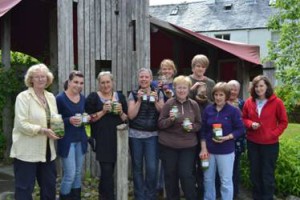
I was away for one week and things seem to have grown and flowered beyond belief! Our Nature walk that follows the River Add next to the Moine Mhor is finally full of colour and our last couple of guided walks have been sunny! They are also yielding new and pleasant wildlife surprises week on week including my first observation of a living adder. I say living because despite camping at a site for years that was notorious for the UK’s only poisonous snake I failed to see a living specimen, but there were countless individuals that had met their end while sunning themselves at the edge of the road. The adder that we encountered on our walk had clearly not read the rulebook on “how to be an adder”. Usually these snakes will feel the vibrations of people walking and make a sharp exit into the undergrowth before you stumble upon them – especially in the middle of hot sunny day. Not this one though and as I did not expect an adder to hang around with a troupe of people marching along a trail I was not keeping a lookout. As I thundered on I heard a sharp gasp behind me and the shout “Adder!” Looking instantly to the spot where their eyes were fixed I could see a very chilled out looking snake that could not care less about the attention it had generated. But that thought came secondary to the realisation that I had just stepped over the top of it without noticing! All of us got a fantastic close up of this usually shy reptile that was happy just to sit – until a camera came out at which point it got a little shy and sloped off into the long grass.
The Schools program has been continuing this month with the Advanced Higher Biology students from Lochgilphead Secondary out on the moss undertaking dragonfly and vegetation surveys to gain experience in practical field studies. Some of the students seemed to have an aptitude for catching dragonfly nymphs from the dammed ditches with a special mention going out to Neil who seemed to have a special skill at catching nymphs and surprising even the dragonfly recorder for Scotland who was assisting on the day.
Finally our solar dying workshop was attended by enthusiastic crafters and artists keen to learn how to use plants to make natural dyes such as those found in Harris Tweed. The day comprised of a short history of this ancient art and the reassurance that we have moved on from using urine as a fixing agent for the dyeing process. We explored what plants you needed for what colours (some a little more surprising than others – willow leaves give a light pink colour) and then took a little trip down to the Great Moss (Moine Mhor). There we explored some of the plants in the wild, where to find them, how to forage responsibly and discovered what animals also make use of them. Back up in the museum garden the newfound knowledge was put into action and a small collection of plant material was gathered for dyeing. The material that was to be dyed was layered up with plants material and an alum solution was added to help fix the colour once it has taken. The rest is up to the sun. The jars take a minimum of 6 weeks to develop and the reaction is powered purely by the sun.


